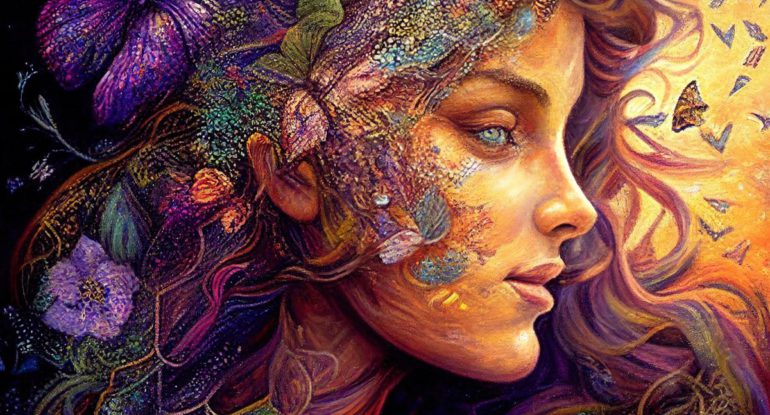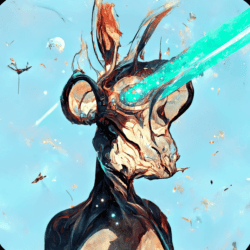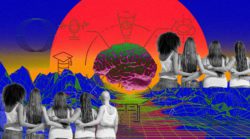Top 10 Ways Generative AI Is Increasing NFT Adoption

Generative AI, also known as generative artificial intelligence, is a field of artificial intelligence that focuses on creating and generating new data or content. Unlike traditional AI models that are primarily used for classification or prediction tasks, generative AI aims to produce novel outputs that are not explicitly present in the training data.
Generative AI utilizes advanced machine learning techniques, such as deep learning, to learn patterns, structures, and relationships within a given dataset. It then leverages this knowledge to generate new examples that resemble the original data. This can include generating new images, text, music, videos, or even interactive experiences.
One of the key components of generative AI is the generative model. This model is trained on a dataset to learn the underlying distribution of the data. Once trained, the generative model can generate new data samples by sampling from this learned distribution. There are several popular generative models used in the field of AI, including variational autoencoders (VAEs), generative adversarial networks (GANs), and autoregressive models.
Variational Autoencoders (VAEs) are generative models that learn to encode and decode data. They consist of two main components: an encoder and a decoder. The encoder takes an input data sample and maps it to a lower-dimensional latent space representation. The decoder then reconstructs the original data sample from this latent space representation. By sampling from the latent space, VAEs can generate new data that resembles the training data.
Generative Adversarial Networks (GANs) are another popular class of generative models. GANs consist of two neural networks: a generator and a discriminator. The generator takes random noise as input and tries to generate realistic data samples, while the discriminator tries to distinguish between the generated samples and real samples from the training data. The generator and discriminator are trained together in a competitive process, where the generator aims to generate samples that the discriminator cannot distinguish from real data. This iterative process allows GANs to produce high-quality and diverse synthetic samples.
Autoregressive models are generative models that generate data by modeling the conditional probability of each data point given the previous data points. They sequentially generate each element of the data, such as pixels in an image or words in a sentence, based on the probability distribution conditioned on the previously generated elements. Popular autoregressive models include the PixelCNN and the Transformer model.
Generative AI has numerous applications across various domains. In computer vision, generative models can be used for image synthesis, image-to-image translation, and data augmentation. In natural language processing, generative models can generate realistic text, facilitate language translation, and aid in text completion tasks. They can also be used in the creation of virtual characters, game design, music composition, and much more.
However, generative AI also poses ethical concerns and challenges. There is a risk of generating misleading or deceptive content, such as deepfakes or fake news articles. It raises questions about the authenticity and ownership of generated content. Moreover, ensuring fairness, transparency, and accountability in the generation process is a critical concern that needs to be addressed.
In conclusion, generative AI is a fascinating and rapidly evolving field that focuses on creating new and original data using machine learning techniques. It holds great potential for innovation and creativity across various industries, but it also demands careful consideration of the ethical implications associated with its applications.
NFTs, or non-fungible tokens, have gained significant attention and popularity in recent years. They are a type of digital asset that represents ownership or proof of authenticity of a unique item or piece of content. Unlike cryptocurrencies such as Bitcoin or Ethereum, which are fungible and can be exchanged on a one-to-one basis, NFTs are unique and indivisible.
The concept of NFTs is made possible by blockchain technology, specifically by utilizing smart contracts on blockchain platforms like Ethereum. Each NFT is associated with a unique token identifier, which distinguishes it from other tokens. This token identifier, stored on the blockchain, serves as a record of ownership and authenticity.
NFTs can represent a wide range of digital or physical assets, including digital artwork, music, videos, collectibles, virtual real estate, and more. They enable artists, creators, and collectors to establish verifiable ownership and control over their digital creations in a decentralized manner. NFTs have opened up new avenues for creators to monetize their work and for collectors to invest in digital assets.
The key features and characteristics of NFTs include:
1. Uniqueness: Each NFT has a distinct identifier, making it unique and distinguishable from other tokens. This uniqueness is essential in establishing scarcity and exclusivity.
2. Ownership and Authenticity: NFTs provide a digital certificate of ownership and authenticity for a specific asset. The ownership record is securely stored on the blockchain, ensuring transparency and preventing unauthorized duplication or modification.
3. Indivisibility: Unlike cryptocurrencies that can be divided into smaller units, NFTs are indivisible. They cannot be broken down into smaller fractions, and each token represents the entirety of the associated asset.
4. Immutable Record: NFTs are recorded on the blockchain, which provides a decentralized and immutable ledger. Once a transaction involving an NFT is confirmed on the blockchain, it becomes a permanent and transparent part of the transaction history.
5. Interoperability: NFTs can be bought, sold, and traded on various online marketplaces and platforms. They can also be integrated into different applications, games, or virtual worlds, allowing for cross-platform ownership and interoperability.
NFTs have seen significant adoption in the art world, with digital artists leveraging the technology to sell and authenticate their digital artwork. The ability to prove ownership and rarity has revolutionized the way artists can monetize their creations. Notable examples include the sale of Beeple’s digital artwork “Everydays: The First 5000 Days” for a record-breaking $69 million at a Christie’s auction.
However, NFTs have also sparked debates and discussions surrounding environmental concerns due to their association with blockchain networks that require substantial computational power and energy consumption. The carbon footprint of blockchain-based systems is a valid concern that needs to be addressed to ensure the long-term sustainability of NFTs and blockchain technology as a whole.
In summary, NFTs have emerged as a groundbreaking technology that enables the ownership and trading of unique digital assets. They offer new possibilities for artists, creators, and collectors, while also raising important questions about the future of digital ownership, copyright, and sustainability.
Importance of Generative AI for the adoption of NFT
Generative AI plays a significant role in the adoption and success of NFTs (non-fungible tokens) by providing the means to create unique and compelling digital assets. Here are several reasons why generative AI is important for the adoption of NFTs:
1. Creation of Unique Digital Assets: Generative AI techniques, such as deep learning models and algorithms, enable the creation of one-of-a-kind digital assets. Artists and creators can leverage generative AI to generate original artwork, music, or other forms of content that cannot be easily replicated. This uniqueness adds value and scarcity to the NFT, making it more desirable for collectors and investors.
2. Enhanced Creativity and Innovation: Generative AI fosters creativity and pushes the boundaries of what is possible in digital art and content creation. It allows artists to explore new styles, techniques, and aesthetics by utilizing algorithms that generate novel and unexpected outputs. This infusion of creativity and innovation in the NFT space attracts attention and drives interest from both artists and collectors.
3. Personalization and Customization: Generative AI can be used to create personalized or customized NFTs. Artists can develop algorithms that take input from users, such as their preferences or personal data, and generate personalized artwork or digital assets. This level of personalization adds a unique touch to the NFTs, making them more appealing to collectors who seek a more tailored and individualized experience.
4. Augmented Collectibles and Virtual Assets: Generative AI can be employed to create generative systems or algorithms that produce collectible items or virtual assets. These generative systems can generate an infinite number of variations, each with its own unique qualities. Collectors can then acquire these generative NFTs, which provide ongoing value and engagement as new variations continue to be generated over time.
5. Combining Multiple Artistic Elements: Generative AI enables the integration of multiple artistic elements into a single NFT. For example, an artist can combine generative music with generative visuals, resulting in an immersive and multi-sensory experience for the collector. By merging different artistic domains through generative AI, the potential for creating captivating and interactive NFTs is significantly expanded.
6. Automated Royalty and Attribution: Generative AI models can be designed to embed royalty mechanisms directly into NFTs. This means that artists can receive automatic royalties each time their generative NFT is resold on secondary markets. Additionally, generative AI can help with attribution by providing a clear record of the generative process, allowing artists to prove the authenticity and originality of their work.
7. Interactive and Dynamic NFTs: Generative AI enables the creation of NFTs that are not static but can evolve and change over time. Artists can design generative algorithms that produce dynamic content, such as animated visuals or music that evolves based on external factors or user interactions. This adds an interactive and dynamic element to NFTs, increasing their value and engagement potential.
Overall, generative AI empowers artists and creators to produce unique, personalized, and innovative digital assets that form the foundation of NFTs. By harnessing the capabilities of generative AI, NFTs become more diverse, compelling, and appealing to collectors, contributing to their broader adoption and market growth.
Also read: Exploring the Power of Generative AI And Its Relation With Blockchain
Top 10 ways Generative AI is increasing NFT adoption
- Creating unique and rare NFTs. Generative AI can be used to create unique and rare NFTs, which can be more valuable than those that are simply digital copies of physical objects. For example, AI can be used to create NFTs of digital art, music, or videos that are one-of-a-kind.

- Making NFTs more accessible. Generative AI can be used to make NFTs more accessible to a wider range of people. For example, AI can be used to create NFTs that are created by machines, which can be cheaper than those that are created by humans. Additionally, AI can be used to create NFTs that are easier to use, such as those that can be bought and sold with a single click.

- Personalizing NFTs. Generative AI can be used to personalize NFTs, which can make them more valuable to collectors. For example, AI can be used to create NFTs that are customized to the buyer’s preferences, such as their favorite color or sports team.

- Generating new ideas. Generative AI can be used to generate new ideas for NFTs, which can help to keep the market fresh and exciting. For example, AI can be used to create new types of NFTs, such as those that are interactive or that have real-world utility.
- Creating NFTs for the metaverse. Generative AI can be used to create NFTs for the metaverse, which is a virtual world that is being created by the convergence of virtual reality, augmented reality, and the internet. For example, AI can be used to create NFTs of virtual land, avatars, or clothing that can be used in the metaverse.

- Making NFTs more secure. Generative AI can be used to make NFTs more secure, which can help to protect them from fraud and theft. For example, AI can be used to create NFTs that are tamper-proof or that can be tracked through the blockchain.
- Making NFTs more accessible to businesses. Generative AI can be used to make NFTs more accessible to businesses, which can help them to expand their reach and engage with new customers. For example, AI can be used to create NFTs that are used for marketing, loyalty programs, or customer rewards.

- Creating NFTs for social good. Generative AI can be used to create NFTs for social good, which can help to raise money for charity or to support important causes. For example, AI can be used to create NFTs of artwork or music that is auctioned off to raise money for charity.
- Making NFTs more fun. Generative AI can be used to make NFTs more fun, which can help to attract new users to the market. For example, AI can be used to create NFTs that are games, puzzles, or other interactive experiences.

- Expanding the possibilities of NFTs. Generative AI is still in its early stages, but it has the potential to expand the possibilities of NFTs in many ways. For example, AI could be used to create NFTs that are used for education, healthcare, or other industries.
Overall, generative AI is a powerful tool that has the potential to revolutionize the NFT market. By creating unique, accessible, and personalized NFTs, AI can help to make NFTs more valuable, secure, and accessible to a wider range of people. As AI continues to develop, it is likely that we will see even more innovative and creative ways for generative AI to be used in the NFT space.
Risks associated with Generative AI
While generative AI offers significant potential and benefits, it also comes with certain risks and challenges that need to be carefully addressed. Here are some of the risks associated with generative AI:
1. Misuse and Malicious Intent: Generative AI technology can be misused for unethical purposes, such as generating deepfakes or spreading misinformation. Deepfakes involve creating realistic but fabricated content, like manipulated videos or images, which can be used for fraudulent activities, defamation, or social engineering. The potential misuse of generative AI raises concerns about the erosion of trust, privacy violations, and the spread of disinformation.
2. Intellectual Property Infringement: Generative AI models can learn from and generate content based on existing copyrighted material. This raises challenges in ensuring that the generated content does not infringe upon intellectual property rights. Striking the right balance between creativity and respecting copyright laws is essential to avoid legal issues and disputes.
3. Ethical Implications: Generative AI raises ethical considerations regarding the ownership and authenticity of generated content. It becomes crucial to establish clear guidelines and standards for attribution, licensing, and intellectual property rights associated with generative AI-generated outputs. Moreover, ensuring fairness, transparency, and accountability in the generative AI process is essential to avoid biased or discriminatory outcomes.
4. Privacy and Security Concerns: Generative AI systems often require extensive training data, which can contain sensitive or personal information. There is a risk of privacy breaches if these datasets are not properly anonymized or if the generated content inadvertently reveals private details. Additionally, securing generative AI models and the data they use from unauthorized access or manipulation is crucial to protect against malicious attacks.
5. Unintended Biases and Discrimination: Generative AI models are trained on datasets that may contain inherent biases present in the data. These biases can manifest in the generated content, perpetuating stereotypes, discrimination, or unequal representation. It is crucial to carefully curate and preprocess training data to mitigate such biases and ensure that generative AI models produce fair and unbiased outputs.
6. Environmental Impact: Generative AI models, especially those utilizing deep learning techniques, often require substantial computational resources and energy consumption. This energy-intensive process can contribute to environmental concerns, such as increased carbon emissions and ecological impact. Developing more energy-efficient algorithms and exploring sustainable computing practices are important steps to mitigate these environmental risks.
7. Legal and Regulatory Challenges: The rapidly evolving nature of generative AI poses challenges for existing legal frameworks and regulations. Determining responsibility and liability for the content generated by AI systems, addressing intellectual property rights, privacy concerns, and ensuring accountability are complex issues that require careful legal and regulatory frameworks to protect the rights of individuals and entities involved.
To mitigate these risks, a multi-stakeholder approach is necessary, involving collaboration among researchers, industry professionals, policymakers, and ethicists. Establishing ethical guidelines, promoting transparency, fostering responsible research and development, and continuously monitoring and addressing emerging risks are vital steps to ensure the safe and beneficial deployment of generative AI technologies.
Also read: Will AI Kill The Value Of NFT artists? Or Will AI Be The Saviour Of NFT World?
Future of generative AI and NFT adoption
The future of generative AI and NFT adoption holds tremendous potential for innovation, creativity, and economic growth. Here are several key aspects that may shape the future of these technologies:
1. Advancements in Generative AI Techniques: Generative AI techniques will continue to evolve, becoming more sophisticated and capable of producing higher-quality and more realistic outputs. Deep learning models, reinforcement learning algorithms, and other advanced techniques will further enhance the ability of generative AI to create diverse and compelling digital assets. This will open up new possibilities for artists, creators, and collectors, driving increased adoption and interest in NFTs.
2. Integration with Virtual and Augmented Reality: The integration of generative AI with virtual and augmented reality technologies will create immersive and interactive experiences for NFT collectors. Artists will be able to design virtual worlds, augmented reality applications, and metaverses where users can engage with generative NFTs in dynamic and engaging ways. This convergence of technologies will blur the lines between physical and digital realities, expanding the possibilities for NFT adoption.
3. Democratization of Creativity: Generative AI has the potential to democratize creativity by enabling more people to participate in content creation and NFT markets. As generative AI tools become more accessible and user-friendly, individuals with limited artistic skills or technical knowledge can leverage these tools to create unique digital assets. This will lead to a broader range of diverse and innovative NFTs, fostering inclusivity and increasing adoption.
4. Enhanced Interoperability and Standardization: The future of NFT adoption will see advancements in interoperability and standardization across different blockchain platforms and marketplaces. Efforts are already underway to establish common protocols, such as the ERC-721 and ERC-1155 standards, which allow for the seamless transfer and exchange of NFTs across different platforms. This interoperability will drive liquidity, ease of use, and broader adoption of NFTs.
5. Digital Identity and Ownership Verification: Generative AI, combined with blockchain technology, will enable improved digital identity verification and ownership tracking for NFTs. Artists and creators can embed their digital signatures or watermarks directly into generative AI models, providing clear proof of authenticity and ownership. This will enhance trust, reduce fraud, and increase confidence among collectors, driving further adoption of NFTs.
6. Cross-Industry Applications: Generative AI and NFTs will extend beyond art and collectibles to find applications in various industries. For example, industries such as gaming, fashion, music, and virtual real estate can leverage generative AI to create unique in-game items, fashion designs, music compositions, or virtual properties that can be tokenized as NFTs. This cross-industry adoption will unlock new revenue streams and business models.
7. Environmental Sustainability: As awareness of the environmental impact of blockchain technology grows, efforts will be made to develop more energy-efficient algorithms and sustainable computing practices in generative AI and NFTs. The industry will explore greener alternatives, such as proof-of-stake blockchain networks, to mitigate the carbon footprint associated with NFT creation and transactions.
In summary, the future of generative AI and NFT adoption is promising. Advancements in generative AI techniques, integration with virtual reality, increased accessibility, interoperability, and improved verification mechanisms will drive the widespread adoption of NFTs across various industries. The convergence of these technologies will unleash new forms of creativity, economic opportunities, and transformative experiences, shaping the digital landscape for years to come.
Leverage the power of #SuiNetwork! With #VMeta3, evolving in-game asset NFTs is a breeze. Experience real-time, dynamic changes in on-chain assets as you level up items like our beloved #Wepet. Let your gaming adventure evolve seamlessly! #BlockchainGaming #NFTs🚀📈 pic.twitter.com/ciWuX4BtoN
— VMETA3 (@Vmeta3Official) June 17, 2023



























































